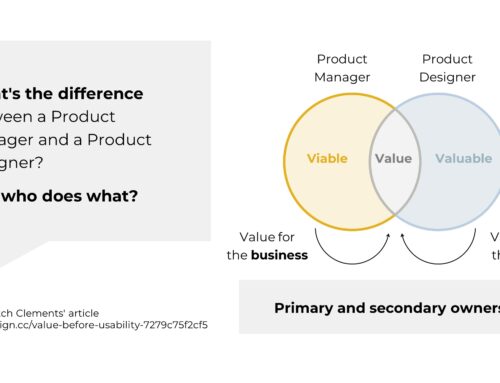During my design metrics class we were discussing the difference between output and outcome metrics when someone asked “the reason people drop off in the funnel, is an outcome or an output metric?“.
I was initially confused by this question, but then I realized why: it was conflating metrics with research.
- The reasons why people abandon have to do with research.
- The number of users who abandon has to do with metrics.
Upon further reflection, I realized that the question stems from a common misconception: conflating the process of measuring product performance with the process of understanding user behavior.
Metrics are used to measure the performance of the product, while quantitative research is used to understand user behavior.
Measuring the performance of a product helps to understand what is happening with the product and evaluate the outcome of design decisions, while the research process helps to understand what is happening to users and to inform design decisions.
Metrics are related to the product. Research is related to the user.
Metrics vs. User Research: Key Distinctions
Metrics and user research serve distinct purposes and employ different methodologies. Here’s a breakdown of their key differences:
They have different objectives:
- Metrics seek to evaluate product performance against specific goals. It uses metrics to measure that outcome.
- Quantitative research seeks to understand users’ needs, motivations, and behaviors. It generates
They have different scopes:
- Metrics show what happened.
- Quantitative research provides insights into the causes behind the observed performance.
They are used at different times and with different frequencies:
- Metrics are used periodically for ongoing tracking.
- Quantitative research is carried out at specific points in time to address particular questions.
They require different skills:
- Metrics require data analysis, interpretation, and visualization skills.
- Quantitative research requires expertise in research methodologies, data collection, and statistical analysis.
They have different uses and impacts:
- Metrics enable data-driven decisions for product optimization and improvement.
- Quantitative research informs strategic decisions with a long-term perspective.
In Summary
It is important to understand both the difference and complementary nature of metrics and user research.
The process of measuring is different from the process of research:
- Measuring a product’s performance helps to understand what is happening with the product and evaluate the outcome of design decisions,
- While the research process helps to understand what is happening to users and to inform design decisions.
Despite being different processes, they are complementary, and the information generated by each one informs and feeds back into the other.
During my design metrics class we were discussing the difference between output and outcome metrics when someone asked “the reason people drop off in the funnel, is an outcome or an output metric?“.
I was initially confused by this question, but then I realized why: it was conflating metrics with research.
- The reasons why people abandon have to do with research.
- The number of users who abandon has to do with metrics.
Upon further reflection, I realized that the question stems from a common misconception: conflating the process of measuring product performance with the process of understanding user behavior.
Metrics are used to measure the performance of the product, while quantitative research is used to understand user behavior.
Measuring the performance of a product helps to understand what is happening with the product and evaluate the outcome of design decisions, while the research process helps to understand what is happening to users and to inform design decisions.
Metrics are related to the product. Research is related to the user.
Metrics vs. User Research: Key Distinctions
Metrics and user research serve distinct purposes and employ different methodologies. Here’s a breakdown of their key differences:
They have different objectives:
- Metrics seek to evaluate product performance against specific goals. It uses metrics to measure that outcome.
- Quantitative research seeks to understand users’ needs, motivations, and behaviors. It generates
They have different scopes:
- Metrics show what happened.
- Quantitative research provides insights into the causes behind the observed performance.
They are used at different times and with different frequencies:
- Metrics are used periodically for ongoing tracking.
- Quantitative research is carried out at specific points in time to address particular questions.
They require different skills:
- Metrics require data analysis, interpretation, and visualization skills.
- Quantitative research requires expertise in research methodologies, data collection, and statistical analysis.
They have different uses and impacts:
- Metrics enable data-driven decisions for product optimization and improvement.
- Quantitative research informs strategic decisions with a long-term perspective.
In Summary
It is important to understand both the difference and complementary nature of metrics and user research.
The process of measuring is different from the process of research:
- Measuring a product’s performance helps to understand what is happening with the product and evaluate the outcome of design decisions,
- While the research process helps to understand what is happening to users and to inform design decisions.
Despite being different processes, they are complementary, and the information generated by each one informs and feeds back into the other.




